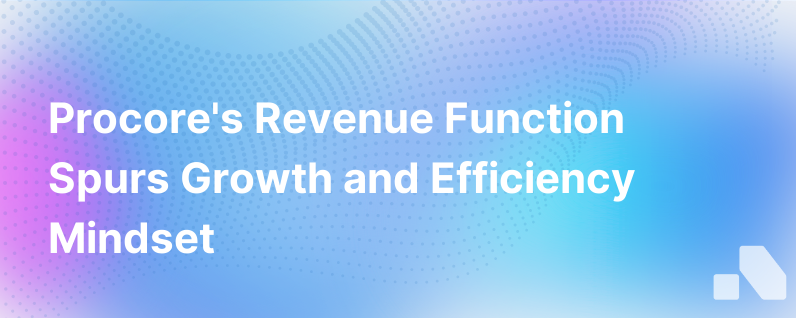
Growth and efficiency are the dual engines of sustainable business scaling, especially in tech sectors where the competition is fierce and the market is unforgiving. At Procore, a leading provider of construction management software, the creation of a new revenue function has proven to be a strategic move that catalyzed considerable growth and efficiency within the organization. This alignment of goals, systems, and teams has set Procore on a trajectory towards maximizing their market potential while streamlining operations.
The Genesis of a New Revenue Function at Procore
The rise of the Revenue Operations (RevOps) function within Procore came from a recognition that traditional siloed operational roles in sales, marketing, and customer support were not serving the agile, holistic approach necessary in today’s fast-paced market. By creating a unified revenue function, Procore sought enhanced alignment across teams, aiming for a more seamless flow from one stage of the customer journey to the next and, ultimately, a better customer experience.
The Intersection of Growth and Efficiency
Creating a new revenue function wasn't merely about organizational restructuring. It was a holistic move that focused on aligning everyone towards the common goals of growth and efficiency. Procore’s leadership understood that efficiency didn't mean cutting costs but making better use of resources – time, talent, and technology – to drive growth.
Customer-Centric Revenue Strategies
The focal point of Procore's strategy was to put the customer at the center of their universe. Procore built their revenue function on the pillars of customer understanding and success. Instead of having disparate teams working towards their internal objectives, they ensured that all teams were working towards the goal of customer-centric growth. This helped streamline operations and ensure that Procore delivers continuous value to customers across their lifecycle.
Integrated Tech Stack
Data is the lifeblood of any modern company, providing insights that fuel intelligent decisions. Procore invested in integrating their tech stack to enable a 360-degree view of the customer. Leveraging data analytics and CRM systems like Salesforce, the team could gain insights into customer behavior, predict churn, and identify up-sell or cross-sell opportunities effectively.
The Cultural Shift
With the implementation of a unified revenue function, a significant cultural shift was necessary to embed a mindset of collaboration and accountability across departments. Departments had to move beyond their micro-goals and metrics to embrace shared objectives and unified KPIs that reflect the company's overarching revenue goals.
Training and Development
Embracing a holistic revenue function necessitated training and development of staff across departments to understand the broader business goals. Procore prioritized cross-functional training, highlighting the importance of each touchpoint in the customer's journey and how it contributes to the company's success. This ensured that each team member could contribute optimally to the company's growth and understand their role's impact on the bottom line.
Outcome-Based Sales Processes
Procore’s sales process became laser-focused on outcomes rather than outputs. This meant prioritizing long-term relationship building and solution-based selling instead of just closing short-term deals. This shift has not only improved customer retention but has also provided more predictable revenue streams.
Aligning Marketing and Sales
In creating the new revenue function, marketing and sales alignment was key. Procore moved to align their messaging, goals, and deliverables. They prioritized lead quality over quantity, resulting in more focussed efforts and better conversion rates. Marketing efforts became more targeted, using insights to craft messages that align with the customer’s specific needs and stage in the buying journey.
Building Efficiency into the DNA
For Procore, one crucial aspect of this transition was making efficiency a part of the company’s DNA. This meant looking at all processes critically and asking whether they contribute to the overarching goals of growth and revenue. It included the embracing of automation and AI to handle repetitive tasks, freeing up human capital for strategic and relationship-driven work.
Results and Reflections
The results of creating this new revenue function were palpable. Procore witnessed increased revenues, customer satisfaction scores, retention rates, and an improvement in team morale as well. The seamless inter-departmental cooperation meant that customers enjoyed a smoother, more satisfying journey, contributing to Procore’s positive market reputation as a customer-focused company.
Continuous Improvement
Procore recognizes that evolution is continuous, and their revenue function is no exemption. With ongoing training, iterative processes, and relentless focus on analytics, Procore continues to refine their approach, uncovering new growth strategies, and further streamlining for efficiency.
The Takeaway for Other Businesses
Procore’s approach to creating a standalone revenue function can be a blueprint for other businesses looking to break down silos and align objectives for growth and efficiency. By creating integrated teams with unified goals, a company can not only improve the customer experience but also unlock the full potential of its workforce and foster sustainable business growth.
Organizations aiming to emulate Procore's success should start with a thorough assessment of their current operations and customer journey. They should then identify where disconnects and inefficiencies lie, and craft a structured plan to align teams around shared goals and metrics that matter.
Conclusion
Procore's decision to crystallize a newly dedicated revenue function has pioneered the efficiency and growth mindset that more companies now aspire to. By redefining their business operations through the fusion of sales, marketing, and customer success, they’ve not only optimized their internal workflows but also provided a stellar customer experience that underpins their industry dominance. Other B2B firms, including ones relying on AI platforms like Aomni for strategic sales approaches, can learn from Procore's innovative framework, ensuring their efforts are not just operationally sound but attuned to the evolving fabric of technological appointments and market dynamics.